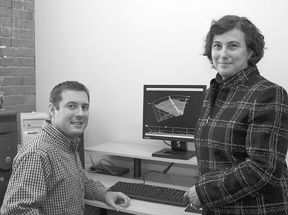After a handful of prototypes and years of sea tests, Providence’s FarSounder
has taken its first commercial product, the FS-3 Sonar, which acts as an underwater
ocean headlight, to the market.
“The horror stories of a barge being just slightly off-channel, or the sea floor changing from a chart that’s 60 years old, are a pretty common thing,” said FarSounder CEO Cheryl Zimmerman. “This is a device that makes a lot of business sense however you look at it.”
Coral reefs are a major problem in tropical waters, as are glaciers in colder waters, but Zimmerman said other, more unpredictable obstacles, such as partly submerged shipping containers, cost the shipping industry $2 billion to $3 billion in annual damages from collisions. FarSounder’s FS-3 is targeted to help large commercial vessels avoid obstacles and was commercially introduced to the marine world last fall. The product is being marketed as the first 3-D, forward-looking sonar.
The technology for the device initially began when Zimmerman’s son, Matthew (who is now FarSounder’s vice president of engineering), collaborated with underwater acoustics expert James Miller, a professor of ocean engineering at the University of Rhode Island, to develop a device to help vessels detect and avoid collisions with right whales.
“The thinking was that sometimes collisions hurt the boats, but collisions always hurt the whales,” Matthew Zimmerman said.
The equipment that has grown out of that project can now provide three pieces of information – range, bearing and depth – to establish a projection of what lies below the waters ahead of a vessel.
While there are several different types of marine sonar available, most use either a narrow beam that looks downward (depth-sounders or fish finders) and shows the ocean floor where a vessel has already been. Two-dimensional sonar only gives two elements, such as side-scan sonar and sonar for small craft navigation, and can’t tell a user how deep in the water an obstacle is.
But the FarSounder team says for obstacle detection – and more importantly, obstacle avoidance – a vessel needs to have real-time access to the ocean floor and the underwater hazards in front of it. FarSounder’s FS-3 model, its first commercial product, uses a 90-degree forward-looking sonar to display a 3-D underwater map every two seconds up to 1,000 feet in front of a vessel.
The sonar transmitter and listening devices are encased in a transducer that is mounted on a ship’s bow and is connected by a cable to a power module about the
size of a briefcase. The user interface runs using Sonasoft, a Windows XP-based
program that can be run on a laptop or marine computer.
While the software can project information as a 3-D image that can easily be manipulated, settings are also available to project the simpler two-dimensional image that saltier sailors may be more comfortable with. Along with displaying vessel location on electronic charts, depth profile, color mapped depth scale, user-selectable depth and detection thresholds, the screen can also display GPS, vessel speed and heading data.
While the team doesn’t actually construct the transducers and other components of its sonar devices, many of the pieces are manufactured in New England and all of the assembly is done in-house. And Zimmerman notes that the entire technical staff (electrical engineer Matthew Coolidge and software engineer Evan Lapisky) consists of URI graduates.
The systems are priced around $60,000 and Zimmerman said the company hopes to begin seeing a profit sometime next year, as well as taking on another 10 employees or so, most to work in sales and marketing.
The company is a partner with two of the Slater Centers, for Marine and Environmental Technology and for Design and Manufacturing. Zimmerman said FarSounder, after being started by Miller and her son in 2001, was able to find much of its early funding through private angel investors and was boosted by signing a teaming agreement with the Naval Underwater Warfare Center in Newport.
Zimmerman, who has a master’s degree in mechanical engineering from Tufts University, owned her own engineering consulting firm for many years in Massachusetts, and joined FarSounder as its CEO in mid-2002.
The company is in talks now with shipyards and barge owners and while Zimmerman said she’s been fielding several international calls, the company is targeting operators along the Louisiana coastline that cope daily with the Gulf of Mexico’s notoriously fickle bottoms.
The company is also hoping to get into defense contracting, taking several meetings with the Navy for a product that could have significant applications for shoreline defense, in-water mine detection, terrorist swimmer detection, and defense of bridges and ports within the next couple of years.
The team also hopes to refine the sonar to one day be able to tell the difference from a partially submerged container and a hostile mine, or a marine animal and a terrorist diver.
“It’s a conservative industry that’s going to take a while to penetrate,” Matthew said. “But the marketing potential is very large.”
Zimmerman said FarSounder will be considering licensing its technology and said the company hopes to eventually refine the product to the point where it is economically feasible for smaller vessels to purchase the device for dock owners and waterfront property owners to use as an underwater security camera.













